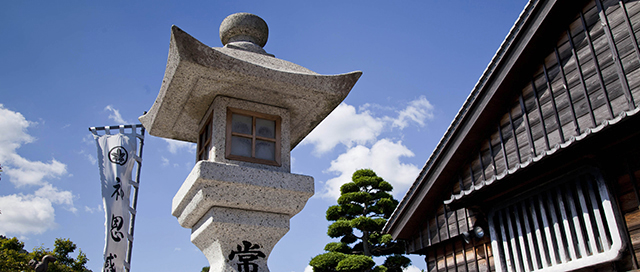Okage Yokocho,Ise Naiku Mae
A town rich with shinon kansha, the spirit of thankfulness for nature’s generosity.

The idea of Okage Yokocho emerged through a deep sense of gratitude for the beautiful surroundings, bountiful resources and appreciation for all living things in the small, tucked away town of Oharai, in front of Ise Jingu in Ise City. Okage Yokocho opened in the summer of 1993, the same year as the sixty-first Shikinen Sengu, an Ise Jingu ritual held every 20 years to remake all of palaces form scratch. In Japanese, the word okage means thankfulness and yokocho means a kind of side street. The word oharai means purification.
Starting in the Japanese Edo period (1603 to 1867), the town of Ise was a destination for countless numbers of pilgrims from across the country wanting to pay their respects at Ise Jingu. It is said that one in every five people at that time made their way to the revered jinja an incredible number of people considering the hardships that came with their journeys. There was even a folk song with lyrics that went, in part, "I want to go Ise, I want to see Ise, at least once in my lifetime."
In spite of the often long and difficult journeys, the routes to Ise were usually filled with weary travelers often in need of a helping hand. Traveling in times past was difficult because of a scarcity of lodging and food as well as the need for authorized permission to venture beyond one's home area. Knowing well the obstacles the pilgrims faced on their journeys to their town, the local townspeople of Ise welcomed their often exhausted visitors with open arms and gratitude. They believed that their generosity and kindness towards these visitors were reverent ways to express their own gratitude to the deities of Ise Jingu.
Times and circumstances have certainly changed since the first pilgrims made their way to Ise long ago but one thing in this town remains and thrives to the present day, shinon kansha, a deep sense of gratitude. Okage Yokocho is defined and operated by local people who work with the very same gratitude of their wondrous surroundings, resources and appreciation for all of nature's generosity.
Within its 3.2 acre site, Okage Yokocho has a beautiful array of architecture dating from the Edo and Meiji periods thereby creating a delightful and historical atmosphere. Some of the buildings have been reproduced using traditional construction methods and others have been relocated from other areas in Mie Prefecture that are along the UNESCO World Heritage recognized Kumano Kodo pilgrimage trails that crisscross Wakayama and Mie Prefectures. Visitors to Okage Yokocho can experience delicious local foods, Japanese history and culture, traditional local customs and the heartening kindness that is famous in Ise.
Okage Yokocho's buildings were constructed in reverence to Shinto shrines and the deities that inhabit them. Because of this, the entrances of the buildings are located on the gable ends of the structures in contrast to a Shinto shrine in which entrances are placed parallel to the ridge lines of the shrines.Additionally, a Japanese method of construction called kizami kakoi has been used to protect the structures against the persistent sea winds and seasonal rains that visit the town during the year. The wood used in the construction of the main buildings in Okage Yokocho comes from a type of pine tree called Tsuga or what is also known as the southern Japanese hemlock.
Okage Yokocho is open and free to visit every day of the year - there is no entrance fee required.
Open daily from 9:30 to 17:30.
August and September: 9:30 to 18:00.
From November through February: 9:30 to 17:00.
(Some restaurants are open until 20:00 throughout the year with some occasional exceptions)
 Open every day of the year.
Open every day of the year. Admission is free (except for the Okage Theater).